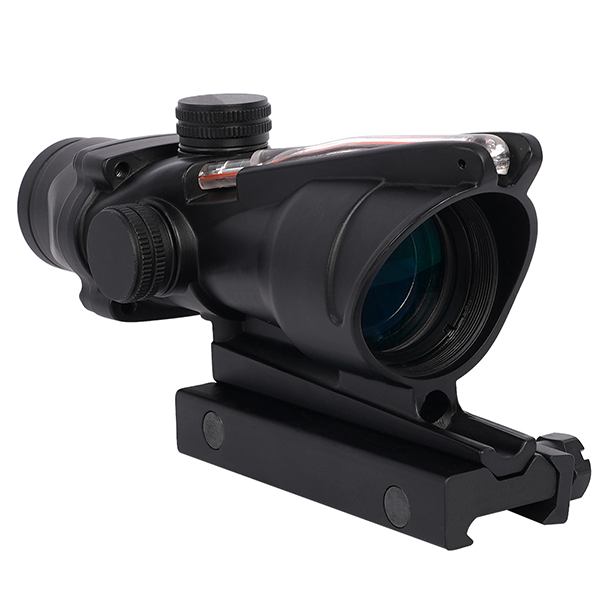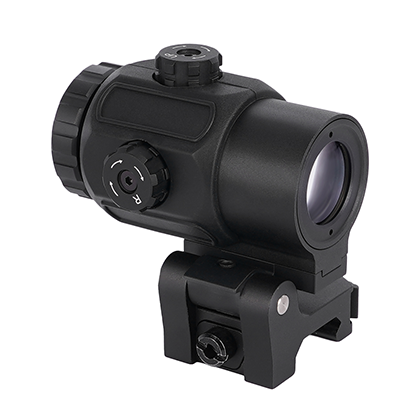Choosing the right rifle scope is essential for improving your shooting accuracy, whether you're out hunting or at the range. With the variety of rifle scopes available, picking the perfect one for your needs can be overwhelming. However, understanding key factors like magnification, objective lens size, and reticle types will help you make an informed decision. This guide will walk you through the most important considerations when selecting a rifle scope, ensuring that you get the best performance for your shooting needs.

Magnification determines how much closer the target appears through your scope. For example, a magnification of 8X means you can see your target 8 times closer than with the naked eye.
It’s tempting to think that higher magnification equals better accuracy, but that’s not always the case. Too much magnification can make it harder to find and track targets, especially at closer ranges. Here’s a simple way to choose the right magnification:
For short-range shooting (up to 100 yards): Opt for 1-4x magnification. This is ideal for target shooting, small game hunting, or home defense.
For medium-range shooting (up to 200 yards): Go for 5-8x magnification, perfect for larger game or shooting in forests and mountains.
For long-range shooting (beyond 200 yards): Choose a 9-12x magnification for precise shots at distant targets in open landscapes like fields or deserts.
Scopes come in fixed power (set magnification) and variable power (adjustable magnification). For versatility, I recommend going with a variable power scope. This allows you to adjust magnification based on your shooting conditions.
The objective lens is the lens at the front of the scope that gathers light to form an image. The larger the objective lens, the brighter the image, but bigger isn’t always better. A larger lens can add weight and increase the chance of sunlight reflecting off it, revealing your position.
Here’s what to consider based on your use:
Low recoil firearms and short-range shooting: Choose an objective lens of 28mm or smaller.
Moderate recoil and low-light conditions: Opt for a 30-44mm lens size.
Long-range shooters or high-magnification scopes in low light: Go for 50mm or larger.
You can identify the objective lens size by the number after the ‘x’. For example, a scope with 2×30 has a 30mm objective lens.
Modern rifle scopes come with various lens coatings to improve image clarity and reduce glare. Here are the types of coatings you might come across:
Coated: A single layer on one surface of the lens.
Fully-Coated: A single layer on all external surfaces.
Multi-Coated: Multiple layers on at least one lens surface.
Fully Multi-Coated: Multiple layers on all exterior lens surfaces.
Most modern scopes come with fully multi-coated lenses, which are the best for minimizing glare and improving visibility, especially in low-light conditions. So, you don’t need to stress too much about lens coatings, as long as they are multi-coated.
The reticle is the aiming point you see when you look through the scope. It’s important to choose a reticle that fits your shooting style. Here are the most common types:
Duplex: Simple crosshairs, ideal for general use like target shooting and hunting.
Mil-Dot: Includes dots for estimating distances based on the target's size. Perfect for long-range shooting.
BDC (Bullet Drop Compensating): Helps estimate bullet drop at different distances, ideal for long-range precision.
Additionally, consider the focal plane of the reticle:
First Focal Plane (FFP): The reticle size changes as you adjust the magnification. This is great for long-range shooters.
Second Focal Plane (SFP): The reticle size remains the same, regardless of magnification. It’s easier to use for short-range shooting.
Windage and elevation turrets are used to adjust your scope’s settings for horizontal and vertical aiming. The windage knob adjusts horizontally (left or right), while the elevation knob adjusts vertically (up or down).
When choosing turrets, look for models with precise, audible clicks, as these help you track adjustments more easily. Some scopes even come with a parallax adjustment turret, which helps eliminate parallax errors, ensuring your reticle stays on target at various distances.

Parallax occurs when the reticle and target don’t align properly, especially at long distances. This can affect your shot accuracy. A scope with parallax adjustment can correct this misalignment, ensuring that your reticle stays on target.
The two most common measurement systems for scope adjustments are MOA (Minute of Angle) and MRAD (Milliradian). Both measure accuracy but in different ways:
MOA: Measures 1” per 100 yards.
MRAD: Measures 0.36” per 100 yards.
While both systems are effective, they are interchangeable. Choose the one that suits your preference or aligns with your shooting group’s standards.
Eye relief is the distance between your eye and the ocular lens of the scope. Adequate eye relief is essential for comfort and safety, especially when using high-recoil firearms. For most firearms, aim for a minimum of 3-4 inches of eye relief to prevent scope bite—a painful injury that occurs when the scope hits your face due to recoil.
Selecting the right rifle scope is crucial for improving your accuracy and performance in the field. By considering factors like magnification, objective lens size, reticle type, and more, you can make an informed decision based on your shooting needs. Whether you’re a hunter, competitive shooter, or just getting started, the right scope can make all the difference.
If you’re looking for high-quality and cost-effective rifle scopes and other optics, Yijing Optoelectronics Technology offers a range of advanced products designed for precision shooting. Reach out to us for expert advice and top-of-the-line optical solutions!